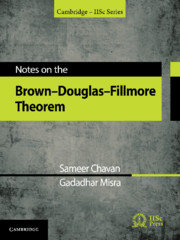Book contents
- Frontmatter
- Dedication
- Contents
- Preface
- From: The Evolution of Modern Analysis, R. G. Douglas
- Overview
- 1 Spectral Theory for Hilbert Space Operators
- 2 Ext(X) as a Semigroup with Identity
- 3 Splitting and the Mayer–Vietoris Sequence
- 4 Determination of Ext(X) as a Group for Planar Sets
- 5 Applications to Operator Theory
- Epilogue
- Appendix A Point Set Topology
- Appendix B Linear Analysis
- Appendix C The Spectral Theorem
- References
- Subject Index
- Index of Symbols
Appendix B - Linear Analysis
Published online by Cambridge University Press: 30 June 2021
- Frontmatter
- Dedication
- Contents
- Preface
- From: The Evolution of Modern Analysis, R. G. Douglas
- Overview
- 1 Spectral Theory for Hilbert Space Operators
- 2 Ext(X) as a Semigroup with Identity
- 3 Splitting and the Mayer–Vietoris Sequence
- 4 Determination of Ext(X) as a Group for Planar Sets
- 5 Applications to Operator Theory
- Epilogue
- Appendix A Point Set Topology
- Appendix B Linear Analysis
- Appendix C The Spectral Theorem
- References
- Subject Index
- Index of Symbols
Summary
In this appendix, we collect some miscellaneous topics from linear analysis referred throughout the main text.
Stone–Weierstrass Theorem
In this section, we present a proof of the Stone–Weiersrass theorem, which does not rely on the Weierstrass theorem. We closely follow the treatment of [119].
Throughout this section, K denotes a compact Hausdorff space.
Theorem B.1.1
Let be an algebra of continuous functions with the following properties:
(1) If, then there exists such that.
(2) For every, there exists such that.
Then, is dense in the algebra of continuous real-valued functions on K endowed with the uniform norm.
We start the proof with a lemma, which shows that under some modest assumption, pointwise convergence yields uniform convergence.
Lemma B.1.1
Let ﹛fn﹜ be a sequence in C[a, b] converging pointwise to a continuous function f. If is decreasing for all, then converges uniformly to f.
Proof Let. For, consider the closed subset
of [a, b]. As,. In particular, finite intersection of sets from ﹛Kn﹜ is non-empty if every Kn is non-empty. If each Kn is non-empty, then by Cantor's intersection theorem,. However, if, then as, for sufficiently large n. Hence, KN is empty for some N, that is, for every x ∈ [a, b] and for every.
Here is an important special case of Weierstrass’ theorem.
Lemma B.1.2
Define a sequence of polynomials by p0(x) = 0, and
If qn(x) = pn(x2), then converges uniformly to f (x) = |x| on [−1, 1].
Proof A routine calculation shows that
One may now verify inductively that
In particular, converges pointwise to |x|. Now apply Lemma B.1.1 to.
The last lemma yields some basic properties of closed subalgebras of.
Lemma B.1.3
Let be a subalgebra of Cℝ(K) and let denote the uniform closure of in Cℝ(K)., then so are and.
Proof Recall that. It may be concluded from Lemma B.1.2 that for ever. The first part now is immediate from
and finite induction, whereas the remaining part follows from.
- Type
- Chapter
- Information
- Notes on the Brown-Douglas-Fillmore Theorem , pp. 201 - 216Publisher: Cambridge University PressPrint publication year: 2021



